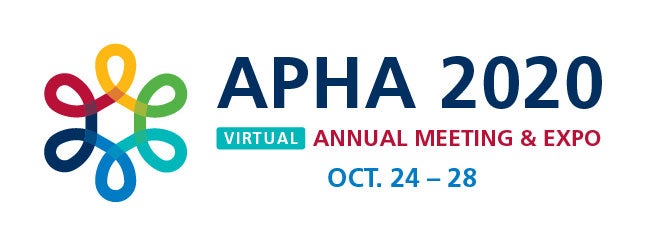Three Top Takeaways from the American Public Health Association Conference 2020
I just attended my favorite conference — APHA (American Public Health Association) 2020. Quoting APHA, “The APHA Annual Meeting and Expo is the largest and most influential yearly gathering of public health professionals, bringing the public health community together to experience robust scientific programming, networking, social events, poster sessions and more.”

I was particularly excited this year as the conference was scheduled to be in my “backyard” (Bay Area, California). However, as a result of COVID-19, the event was cancelled and instead moved to a virtual format. That said, I was grateful for the opportunity to experience it in this way. While I did miss the ability to connect with colleagues and meet other passionate public health professionals face to face, I appreciated the ability to jump from session-to-session easily, and the ability to post questions in the chat box. Gone were the days of nervously standing up in front of the crowd and waiting for someone to bring over the mic.
What didn’t change was that the content was relevant and inspiring, and I’m excited to share three top takeaways, with lots of references for you to peruse.
Get ready: The time to prepare for the COVID-19 vaccine is now.
Vaccines are one of the most important tools in the public health toolbox, and I know we are all anxious for a safe and effective COVID-19 vaccine when it becomes available. The good news is that there are currently eight COVID-19 vaccines in stage three (final robust stage to ensure efficacy and safety) of development, and therefore it is likely that we will see one with approval soon. The FDA has also taken measures to ensure approved vaccines will be safe and effective and that the benefits outweigh the risks.
When a vaccine is approved, however, it will take time to vaccinate a significant part of the population, which will be essential in order to move forward as quickly as possible. In fact, until herd immunity is reached, which is the goal of any successful vaccination campaign, current prevention measures will remain important to help mitigate the spread of the infection. So, while a vaccine is coming, social distancing, wearing masks, and hand and environmental hygiene won’t be going away for a while.
Another thing to prepare for is who will get the vaccine first, as demand is surely going to outpace supply. The National Academies of Sciences, Engineering and Medicine has published a Framework for prioritization of vaccines, based on those who need it most. Take a look and see where you and your employees line up.
Double check: Workplace safety is more important than ever.
According to the Occupational and Safety and Health Administration (OSHA), current requirements apply to preventing occupational exposure to SARS-CoV-2 (the virus that causes COVID-19). In addition, there are 28 OSHA-approved State Plans, operating statewide occupational safety and health programs, with standards and enforcement programs that are at least as effective as OSHA’s and may have different or more stringent requirements.
Despite these facts, there continue to be concerns about too many workplace related deaths, injuries and illnesses each year, and concern continues to build as the U.S. works to keep the economy strong while controlling the spread of COVID-19. A recent assessment published by The Harvard Center for Population and Development Studies found a correlation between COVID-19 complaints to OSHA, and U.S. deaths 17 days later, suggesting ineffective workplace protections may be a driving factor behind the high U.S. death toll.
This and other data has led to a number of states, including Virginia, Oregon, Michigan and California to take additional measures (in the form of Executive Orders and/or Emergency Temporary Standards) to protect workers against COVID-19. Public health leaders like David Michaels, Ph.D, MD from George Washington University believe that ensuring employee health and safety is essential if we are going to stop the pandemic. With COVID-19 cases at an all-time high, it’s a good time to double check that you are doing everything possible to protect yourself and your employees from the consequences of infection with the virus.
OSHA also requires employers to protect workers from exposure to hazardous chemicals used for cleaning and disinfection, which is another important consideration given the increase in cleaning and disinfecting that many businesses have adopted as a result of the pandemic.
Get involved: Public Health is everyone’s business.
While much of public health is funded by government and non-profit organizations, public health helps everyone and should be a shared responsibility. The more we can all get involved, the less reliant we will be on the government for this basic human right.
Getting involved is easy. Here are some ideas to help you get started:
- Learn more about public health and public health issues. This can be done by reviewing the recently published Healthy People 2030 priorities, the renewed 10 Essential Public Health Services, attending free webinars sponsored by APHA, and by attending APHA 2021 in Denver Oct 22–27.
- Provide health and wellness programs for all employees, and prioritize keeping them safe at work by preventing exposures to dangerous situations and workplace accidents. As an added bonus, helping employees stay physically, mentally and emotionally healthy can pay dividends for businesses later on.
- Prioritize the development of products and services that seek to make a difference to public health.
- Donate funding, expertise and/or time to groups that work hard to improve public health.
- Volunteer in Public Health.
If you’re already involved, these ideas can help you continue with your public health journey. Remember, as the late C. Everett Koop (former pediatric surgeon and U.S. Surgeon General) once said, “Health care is vital to all of us some of the time, but public health is vital to all of us all of the time.”


